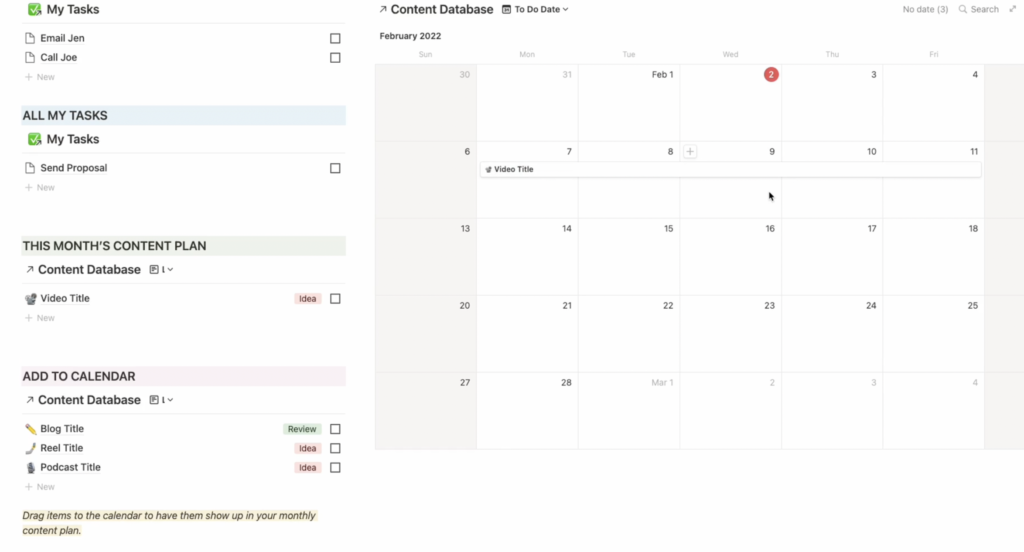My favorite thing about Notion is how customizable it is, but that also means that there are a million ways to set up your workspaces. Personally, I like to keep things simple with a Notion dashboard that organizes all my tasks and content in one place.
Here’s how to create your own Notion dashboards with linked databases!
Love Notion, but don’t love setting it all up for the first time?
Purchase my super simple Notion to-do list templates (and if you want all my Notion dashboard templates you can add them after checkout). Grab 50% with the code BLOG for a limited time by clicking here.
VIDEO TRANSCRIPT: My Secret to Creating Simple Dashboards in Notion
Hey, I’m Galen from Local Creative Co. and I am back today with a, another Notion tutorial, because you seem to love them a lot. They’re like my most popular videos on my channel right now. So if you want to learn more about notion for small business or Notion for creatives, make sure to subscribe to this channel.
So, you don’t miss any more videos I put out in the future.
In this tutorial, I’m going to show you how to create a super helpful Notion dashboard with everything in one place. So that way you’re not hunting through your pages, trying to find the information that you need each and every day to do your job well.
I am a web designer and a content creator, and I use Notion as a way to collaborate with my team and to plan out all of my content. So I know what’s going to be created. And when, when it’s getting published and just kind of keeps everything organized in one space.
One of my favorite things about Notion is how flexible it is and how easy it is to customize it, to fit your unique needs. The downside to that is that there are a million different ways to set up your own dashboard and to set up your own space. So it can be really easy to get overwhelmed in the process.
I have a membership community called the Creator Club where I go over all of the systems that I use in my creative business. And I give away a ton of my notion at templates. So if the template like the one you’re going to see in this video shortly is one that is interesting to you. Make sure to sign up for the club at the link in the description below.
Let’s dive in it to my template.
So this template here says content plan, but I actually use this same template to manage everything that I have going on in my business. I have all of the team tasks. I have a small team or a team of three right now. So I have all the tasks that we’re collaborating on that are coming up soon. Those are listed here. I have my monthly content calendar, and any other pages that I want to visit frequently, I will keep links to those here as well.
My main tip for getting started with notion content databases, or any database is to try to have as few databases as possible. So for example, I have one database for all of our team tasks and I have them assigned to different people on the team. And then I have one database for all of our content. Rather than having one database for YouTube videos, another one for podcast episodes, another one for blog posts. I have one database and then I use properties to determine what type of content is in that database.
The really nice thing about keeping things simple this way and creating as few databases as possible is that you can create linked databases, which are basically just separate copies of that database. And then you use filters to drill down on each one. So they show you a different set of content.
Using that example, I could create a linked database here and to do that, you’re just going to hit forward slash and then you’re going to type in linked database or start typing that will pop up for you. And then you can link to an existing database in your Notion set up. So I’m going to choose the, my task database here. I’m going to turn this into a list view.
And then I am going to use the filtered options to filter this down to show only tasks that are assigned to me. So I would add a filter. This is not my actual Notion database. It’s just a sample. Right? So it doesn’t really have any information in it, but I’m going to assign it and show any database or any tasks that are specifically assigned to me.
They’re going to show up in this top section here, I’m also going to add another filter and. And only show tasks that are not done. So I chose, um, this is my filter, right, where assigned contains me and where done is unchecked. And that way I’m only going to see tasks assigned to me and tasks that have not been done yet. You could also filter by timeline. So maybe let’s see if I have that in here already.
I have a timeline, right? So I could filter by tasks that are going to get done today or tasks that I. I want to get done today. So I’m going to save that and then I’m going to change this to my tasks for today. And what’s really cool. And I’m actually going to get rid of this original table that I created. I just want the list view here. I am going to duplicate this. Actually, I’m going to highlight. I’m pressing shift and then I’m just using the down arrow key here to highlight everything I’m on a Mac. So I’m going to choose command C to copy. And then I’m going to enter down a few lines. Press command V or if you’re on a PC control V and I just pasted that right here. Now I’m going to do, um, my.
All my tasks. I could add this here too, or I could say all my team tasks and for this one, instead of, and timeline is today I am going to choose and timeline is not today. So now I have two different linked databases. It’s all the same. My tasks database.
But I’m able to create different views. So this task is for today. This could be email Jen, for example, just picking a random task here. And this one down here could be let’s call this one. Call Joe. Or send proposal and then I would choose a different timeline, right? Maybe this is this week and this one here, we can set a deadline if we wanted to, but I’m going to set the timeline. For this week as well. And then the other thing I’m going to do is change the properties that I want to have show here. I might have, I’m not going to have it show assigned because these are only my tasks, so it’s just going to be me. But I am going to put that little done there. I am going to put the the status of that particular task.
And then down here, Same thing. I’m going to set this up the same way. I’m going to go to properties. I’m going to, I love always having that done checkbox there. And for this one, I’m going to leave off a sign as well. Cause it’s just my tasks and I’m going to put the status here too. And I’m actually going to remove the last edited date because that’s not relevant. So now I’m kind of seeing this come together. This looks really good. Again, same database shown two different ways. I just copied and pasted it. Any tasks that I, um, that show in this database, right? I can actually just drag them around. So by jogging, call Joe from the, all my tasks to today’s tasks, I just switch the timeline to today. So I really love being able to see this content in multiple lights.
Here’s another one down here. I created a content database. You can see the. Content database is here, here and here, which is the exact same database in three different ways, but I’m using different filters based on the time. So here I have, uh, this particular one is this month’s content plan I have where the timeline is within the past month or the timeline is within the next month.
Then for this one here, the content database, this let’s see what the filters are for this one, where timeline is empty. These are content pieces of content that I need to add to my calendar because they do not have a timeline. And then over here, what I can do is I can take a video and I can drag it to the monthly calendar over on the right. And by doing that every time I add it to the monthly calendar, you will see it actually disappears. From that add to calendar section on the left. So by adding it to my calendar, it is no longer in this section here. And that is because of the filters I have created.
Having multiple linked databases in one place showing different sets of the same content is so, so powerful when it comes to creating dashboards because a you’re able to drag content quickly between different databases or even between the same database. And you’re able to watch it move based on the filters that you have said.
If you want to learn more about notion, let me know. In the comments below what you’re most excited to learn about.
Thank you so much for watching. I hope you enjoyed this video and I can’t wait to see you inside the Creator Club . If you decide to join us there, have a good one and I’ll see you next time.
How to Create a Dashboard in Notion
Here’s how I create Notion dashboards to display my upcoming tasks and content.
STEP 1: Create your necessary databases.
All of my tasks, to-do list items, and pieces of content live in databases inside Notion. I recommend using as few databases as possible to keep things simple.
For my Notion dashboard, I use two databases:
- Tasks. This includes to-do list items for my entire team. I use the properties function to add due dates, assign them to different team members, and label the status of the project.
- Content. This includes everything from blog posts to podcast episodes to emails. I organize them based on when they’re going to go live and who’s assigned to complete them.
Once you create your database and add tasks, you can add it to your Notion dashboard using the /linkeddatabase function.

STEP 2: Organize and filter linked databases.
Once you link your database in your Notion dashboard, filter it to show only the tasks you want displayed in that section. Here, I set up a “My Tasks for Today” section and filtered it to show only tasks assigned to me that are due today but not yet complete. You can also experiment with list or database views and which properties you want shown on the dashboard.

STEP 3: Get creative with your Notion dashboard!
Now, it’s time to get creative! Repeat this process for other views of your tasks, such as…
- Upcoming tasks for team members that aren’t yet complete
- Recently completed tasks by team members
- Tasks that still need to be assigned due dates
You can also try displaying your tasks in different views, like content calendars or boards for long-term projects. It just depends on how you prefer to keep everything organized. Also experiment with a personal Notion dashboard and a business-related one.
Of course, any Notion dashboard wouldn’t be complete without a cool cover and icon. Add your own spin to your dashboard to make it something you’ll be excited to open every day.

Grab My Latest Notion Templates for 50% Off!
Purchase my Notion to-do list templates (and if you want all my Notion dashboard templates you can add them after checkout). Grab 50% with the code BLOG for a limited time by clicking here.
Want to learn how to use Notion to organize your life and business?
Here are a few more posts you may want to checkout next…